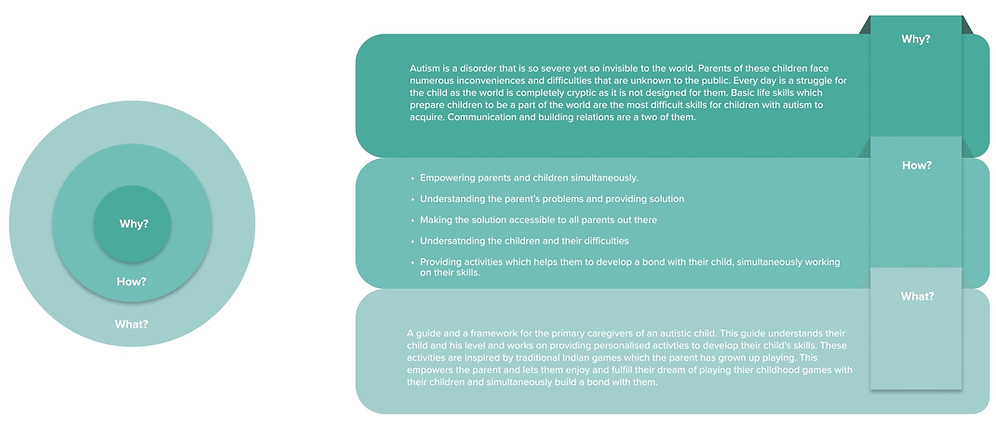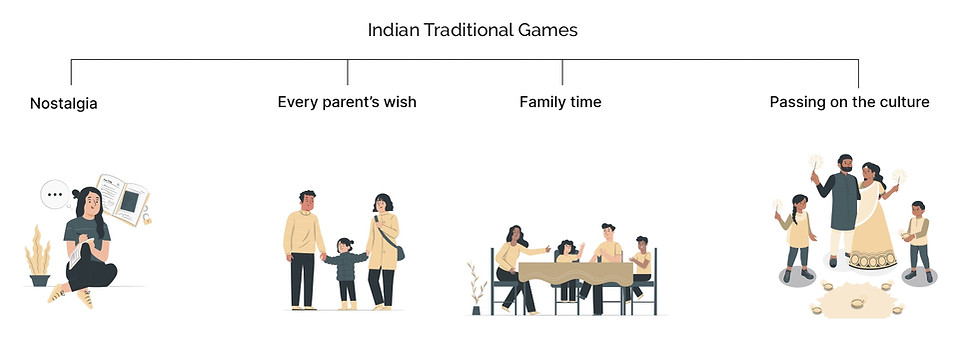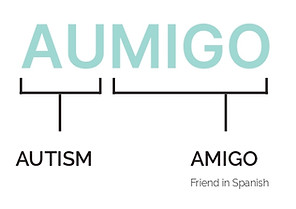AUMIGO
A new companion in your autism journey
Project Overview
Aumigo is a service designed for parents of autistic children to help ease the journey of managing autism. Aumigo consists of two major touch points. A digital application designed for the parents guides them on how to play and teach their children basic skills and a physical intervention consisting of various activities and games designed for the children which are facilitated to the parents through the app.

Role
Thesis Project with Microsoft Research, India (Ludic Design for Accessibility Team)
Ethnographic Research, UX-UI Design, User Study
Duration
February - June 2022
Tools Used
Figma, Adobe Suite, Google Forms
What is Autism?
Autism spectrum disorder impacts the nervous system and affects the overall cognitive, emotional, social and physical health of an individual.
The range and severity of symptoms can vary widely. Common symptoms include difficulty with communication, difficulty with social interactions, obsessive interests and repetitive behaviour.
Challenges faced

Why Autism?
While the disorder is not rare, a multitude of people with autism in India have not been diagnosed and do not receive the services they need.
Currently, the needs of autistic children in India are not being met in either the regular or special education systems.
The autism movement in India has come a long way in the past two decades, but there is still a lot of work to be done.
After the initial primary and secondary research, I narrowed down on interpersonal skills for autistic children.
Why interpersonal skills?
Helping children with autism to develop interpersonal skills is one of the first steps in making them independent.

Parents' perspective
Sometimes if he could just tell me what is wrong...
Communicates through gestures and symbols. We are trying to make him as independent as possible...
If I could just pop his bubble/ his world he is in, he will be like everybody else...
User Personas
It was evident that there would be two primary users of the platform.

PRIYA BAPAT - MOM
-
Mother to a 9 year old girl and 5 year old boy
-
On a break from her career
-
Proudly walking through the journey of autism
-
Would like to pursue her career again
Goals:
-
Help her son predict conversations better so he knows what to say, when and how
-
To help her son communicate properly
-
Have an individual identity and have some time to herself in the day
Frustrations:
-
Not being able to track the development of her son efficiently
-
Therapy being very expensive and not easily accessible
-
The worry of "what will happen when I am not there"
-
Having very less first hand information, not knowing where to begin
ASHU BAPAT - SON
-
Verbal
-
Goes to special school
-
Got diagnosed when he was 2
Goals:
-
To have small conversations with mom and peers
-
Build relationships and friends
-
Learn to communicate
Frustrations:
-
Not being able to predict replies
-
People around me not understanding my difficulty
-
Not being able to pay attention
-
Not being able to put words together

Problem Statement
How might we improve the interpersonal skills of the autistic children who are high functioning and verbal and provide their parents with the guidance for the same?
Quotes by Therapists and Parents
After identifying problem statement, primary research was conducted again. This helped in identifying the nuanced details of the problems faced before beginning the process of ideation.
No learning should happen through screen for autistic children
Learning of language should happen through everyday activities
Shared attention gets better - attention gets better - listening gets better - language gets better

Its difficult for him to pay attention. He just wants to finish it off
There are times when we are going backwards
My husband was in denial for the initial years which lead to us being distant

I left my job and decided to give my 100% to my son
Therapies are expensive and are difficult to access
Taking a child to the therapy and bringing him back is a task in itself. Its very far and takes a lot of driving. The absence of us is difficult to explain to others when we want to keep it discrete

Affinity Mapping
To analyse insights from the interviews affinity mapping was done. There were several categories which were identified for an intervention.


help the autistic children to communicate better by helping them predict the conversation?

offer remote guidance to parents of autistic children to navigate through the course of caretaking?

develop better training tools to help autistic children to communicate?
How might we
To guide the ideation, 3 main how might we questions were formed.
Ideation

Constraints
Child:
-
Physical
-
Accessible in remote areas
-
Adaptable
-
Playful
-
Fun
Parent:
-
Virtual / Physical
-
Accessible in remote areas
-
Adaptable
-
Playful
-
Fun
Putting few constraints to first ideate for the two target audiences separately and then combining the ideas that go well together.
Constraints were important as the there are two different requirements of the both the target audiences.
Validating ideas through survey
Before finalising the ideas, a survey was conducted to understand what would benefit the target audience. This survey was posted on the various Facebook autism pages. The survey collected 30 responses in total.
57.4% did not have any experienced parent in touch with them.
64.3% said they would like to get tips from a parent who has more experience.
71.4% said they would appreciate having a friend who has an autistic child and is having similar experiences.
65.2% said having a visual/measurable results of skill development will benefit them.
Finalising the idea
The final idea combines three concepts that, after thorough validation, proved to be the most suitable. These ideas address the primary challenges faced by both parents and children.

An app which helps the parent by giving a basic framework with which they can work with their child by adapting and cutomising the solutions
A game / app that provides activities based on your child’s abilities/disabilities and doesn’t let you unlock the next level and activity till he masters that activity
Tangible progress bar
Tinder/bumble like app for parents to meet and plan a play date with their kids
An application that guides parents to conduct activities and play with their child. These activities will be suggested according to the child’s capabilities and weaknesses. These activities will come in various levels and it won’t let you unlock the next one until to master the previous level. The application will also have a space where you can contact parents of other autistic children and learn and provide more information about autism.
Detailing out the idea
Golden circle was used to detail out the idea. Answering why, how and what is my primary step to start developing the idea.

Touchpoint 1: Application
User flow

User flow was mapped to understand the basic content and experience of the application.
Paper wireframes
The first step towards defining the structure of the application was to sketch rough wireframes on paper. This helped me in defining the design language and understand how certain features would look and work. Not all screens were drawn in this manner as I found the software easy to let me try various iterations.


Wireframes
Wireframes were created with relevant information present in it. The intention was to create a low fidelity representation of the final concept.
This aided in user validation process which guided essential changes for the high-fidelity version.
Style guide


Evaluation pages have multiple scenarios which upon filling shows the parent the level of thier child.

This screen is seen once the parent
complete answering the scenarios.
It shows the parent on what level their
child lies and takes them to activities
or skills page.

Here the parent sees different activities that will help their child with
developing their weaker skills.
It also lets them search with filters.

The home page shows the parent how
many day they have been on the app and your activity status. It also shows them their child's progress by comparing the graph from once they joined and current date.

This screen shows the parent different
super moms/dads who are going
through the same journey as them
and they can connect with the most
compatible one. This screen also shows them about the other parent's child so they can initiate conversations along those lines as well.

This screen shows different therapists and lets the parent either directly talk to them or also book an appointment and schedule a conversation.
Touchpoint 2: Activities
Inspiration

Activity 1
Hopscotch
-
Learning how to make sentences
-
Learning gestures
-
Communication through play
Level 1
Getting familiar with the game and it's elements
Level 2
Introducing the words and making 2 word sentences
Level 3
Making 3 word sentences + salutations
Level 4
Making 4 word sentences + emotions
Level 5
Making 4 word sentences + emotions + adjectives


This activity has a print and play version if the parent don't wish to invest in the kits. The activities are also displayed and taught on the application to the parent.
Activity 2
Snakes and Ladders
-
Learning about social interaction
-
Introduction to behaviour, mannerism in social scenarios
-
Learning through play
-
Understanding the concept of wrong / inappropriate
Level 1
Getting familiar with the game and it's elements
Level 2
Follow the numbers according to the dice
Level 3
Introducing the snake and the ladder
Level 4
Giving social scenarios with answers
Level 5
Giving social scenarios without the answers


This activity has a print and play version if the parent don't wish to invest in the kits. The activities are also displayed and taught on the application to the parent.
Activity 4
The Card Game
-
Learning emotions
-
Understanding losing and winning
-
Learning through play
-
Understanding the concept of wrong / inappropriate
Level 1
Getting familiar with the game and it's elements
Level 2
Guessing emotions without cards - dumb charades of emotions
Level 3
Enacting emotions with scenarios
Level 4
Understanding body language and detailed emotions
Level 5
Play react game with them


This activity has a print and play version if the parent don't wish to invest in the kits. The activities are also displayed and taught on the application to the parent.
Activity 5
Pick a card
-
Building bonds
-
Understanding teamwork
-
Learning life skills
-
Understanding surroundings and environments
Level 1
Understanding the products required
Level 2
Getting the ingredients ready
Level 3
Make chutney
Level 4
Start putting the sandwich together
Level 5
Serve


This activity has a print and play version if the parent don't wish to invest in the kits. The activities are also displayed and taught on the application to the parent.
Identity design
I attempted logo design for the service as well :)


The logo was an amalgamation of three different forms. All three forms depicted the traits of neuro-divergency.

Butterfly
Emerging as a new symbol of Autism as it portrays the beauty of diversity and continued development.

Rangoli
A sign of Indian tradition.
My interpretation of the form:
Neuro-typicals follow a set path, whereas neuro-divergents make their own path through their perception of the world.

Infinity
The symbol of neuro-divergency




